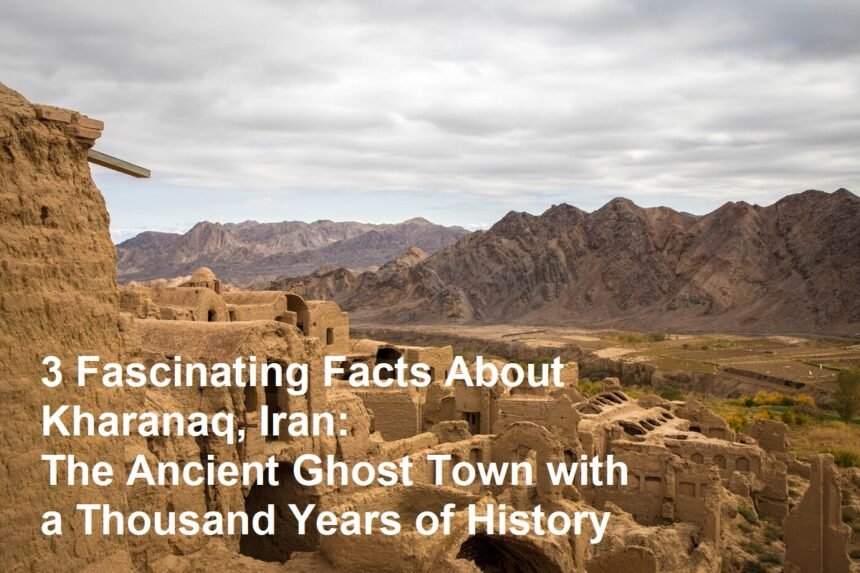Introduction
Nestled in Iran’s rugged landscape, the ancient town of Kharanaq stands as a testament to centuries of history, resilience, and mystery. Often referred to as a “ghost town,” Kharanaq has captivated explorers, historians, and travelers alike with its remarkable architecture, storied past, and haunting beauty. Despite being largely abandoned today, this ancient settlement continues to whisper tales of a bygone era. Here are three fascinating facts about Kharanaq, Iran, a city that has thrived for over a thousand years.
1. A Rich History Dating Back Over a Thousand Years
One of the most incredible aspects of Kharanaq is its age. The city is believed to have been inhabited for at least 1,000 years, potentially even longer. Its history dates back to the Seljuk Empire in the 11th century, and it flourished as a vital trading and caravan route stop along the Silk Road. The strategic position of Kharanaq allowed it to serve as a marketplace and cultural hub, facilitating trade between Persia and neighboring regions.
Throughout the centuries, Kharanaq witnessed the rise and fall of various dynasties, including the Safavids and Qajars, which influenced its architecture and infrastructure. The city was renowned for its well-built mud-brick structures, traditional qanat irrigation systems, and narrow winding alleyways that kept the settlement cool during scorching Iranian summers.
What makes Kharanaq especially fascinating is the fact that many of its structures are still remarkably intact, considering their age. Its historical significance is underscored by the presence of a towering fortress, ancient bathhouses, caravansaries, and a mosque, all built with skillful craftsmanship that has withstood the test of time.
2. A Deserted Yet Mystical “Ghost Town”
Today, Kharanaq is largely deserted, earning it the nickname “ghost town.” Decline began around the 20th century when modern infrastructure and transportation routes shifted away from the area, leading residents to migrate to nearby cities such as Yazd and Arak. Despite a small number of inhabitants remaining, the majority of Kharanaq’s once-thriving community has vanished, leaving behind a ghostly landscape of crumbling buildings and empty streets.
Despite its abandonment, Kharanaq holds an almost mystical allure. The dilapidated structures, set against a backdrop of the desert and rugged mountains, create an otherworldly atmosphere that draws photographers, historians, and adventure seekers. Many believe that the city’s eerie silence and weathered architecture carry the spirits of those who once called it home, adding to its reputation as a haunted or mystical site.
Restoration efforts have been quietly taking place to preserve the remaining structures. These efforts aim to protect the town’s unique architecture while also promoting it as an archaeological and cultural site. Visitors are often struck by its haunting beauty, wandering through the ancient streets, peering into abandoned homes, and imagining the bustling life it once contained.
3. A Unique Architectural and Cultural Heritage
Kharanaq’s architecture is a living testament to traditional Persian building techniques adapted to the harsh desert environment. Its homes, mosques, and other structures are primarily made of sun-dried mud bricks, which naturally regulate indoor temperatures. Narrow alleyways and courtyards provide shade and protection against the intense desert heat, demonstrating an intelligent adaptation to the environment that has persisted for centuries.
One of the most iconic landmarks in Kharanaq is its towering fortress, which offers panoramic views of the surrounding desert and mountains. The fortress, built to defend the city from invaders, features thick walls and watchtowers that have survived the ravages of time. Nearby, the ancient caravanserai served as a resting place for traders traveling along the Silk Road, emphasizing the city’s historical role as a vital trade link.
Furthermore, the town’s qanat irrigation system—an ancient method of underground water channels—illustrates the ingenuity of its inhabitants. These qanats supplied water to the city’s residents and cultivated land even in the arid climate, showcasing sustainable engineering techniques still admired today.
Despite its abandonment, Kharanaq continues to hold cultural significance. It reflects the resilience and adaptability of Persian civilization, and efforts are underway to preserve its heritage for future generations. Some local entrepreneurs and historians are considering developing Kharanaq as an archaeological tourism site, helping to fund preservation projects and boost the local economy.
Conclusion
Kharanaq, Iran, stands as a captivating reminder of a rich and ancient civilization. Its history spanning over a thousand years, its hauntingly beautiful ruins, and its innovative architecture make it a must-visit for history lovers, explorers, and anyone interested in Iran’s storied past. Although it largely remains a ghost town, Kharanaq’s spirit endures through its stone structures, silent streets, and the stories of generations long gone. As efforts to preserve this ancient city continue, it remains a mesmerizing symbol of resilience, cultural heritage, and the timeless allure of Iran’s vast history.












